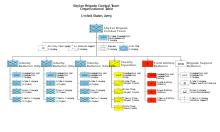
Back لواء (وحدة عسكرية) Arabic لواء (وحده عسكريه) ARZ Brigada AST Briqada Azerbaijani Брыгада (войска) Byelorussian Брыгада (войска) BE-X-OLD Бригада Bulgarian ব্রিগেড Bengali/Bangla Brigada BS Бригада BXR
| NATO Map Symbols[1] |
|---|

|
| a friendly brigade |

|
| a hostile brigade |

|
| a friendly infantry brigade |

|
| a friendly combined-arms brigade |

|
| a hostile armored brigade |

|
| a hostile engineer brigade |
A brigade is a major tactical military formation that typically comprises three to six battalions plus supporting elements. It is roughly equivalent to an enlarged or reinforced regiment. Two or more brigades may constitute a division.
Brigades formed into divisions are usually infantry or armored (sometimes referred to as combined arms brigades). In addition to combat units, they may include combat support units or sub-units, such as artillery and engineers, and logistic units. Historically, such brigades have sometimes been called brigade-groups. On operations, a brigade may comprise both organic elements and attached elements, including some temporarily attached for a specific task.
Brigades may also be specialized and comprise battalions of a single branch, for example cavalry, mechanized, armored, artillery, air defence, aviation, engineers, signals or logistic. Some brigades are classified as independent or separate and operate independently from the traditional division structure. The typical NATO standard brigade consists of approximately 5,000 troops. However, in Switzerland and Austria, the numbers could start as high as 10,000 troops. The Soviet Union, its forerunners and successors, mostly use "regiment" instead of brigade, and this was common in much of Europe until after World War II.
A brigade's commander is commonly a major general,[note 1] brigadier general, brigadier or colonel. In some armies, the commander is rated as a general officer. The brigade commander has a self-contained headquarters and staff. The principal staff officer, usually a lieutenant colonel or colonel, may be designated chief of staff. Until the late 20th century British and similar armies called the position 'brigade-major' and most British brigades have a major as the chief of staff. Some brigades may also have a deputy commander. The headquarters has a nucleus of staff officers and support (clerks, assistants and drivers) that can vary in size depending on the type of brigade. On operations, additional specialist elements may be attached. The headquarters will usually have its own communications unit.

In some gendarmerie forces, brigades are the basic-level organizational unit.
- ^ APP-6C Joint Military Symbology (PDF). NATO. May 2011. Archived from the original (PDF) on 2015-09-21.
Cite error: There are <ref group=note> tags on this page, but the references will not show without a {{reflist|group=note}} template (see the help page).
© MMXXIII Rich X Search. We shall prevail. All rights reserved. Rich X Search